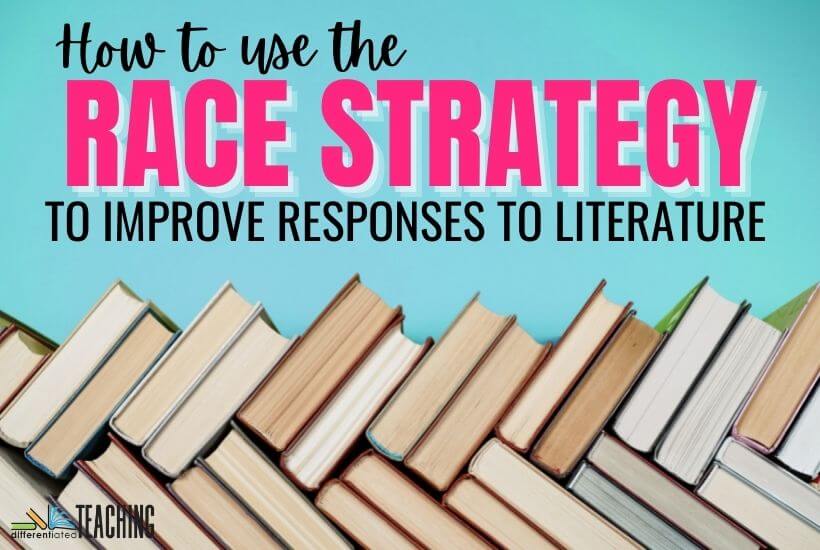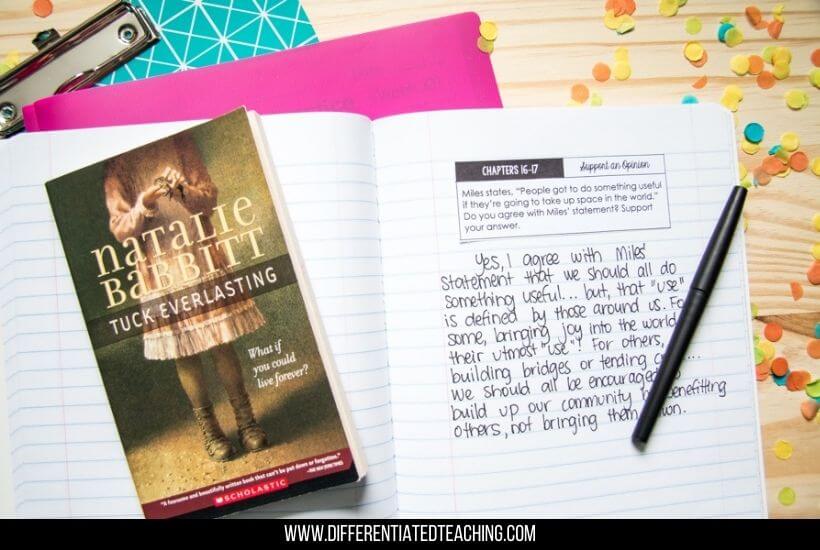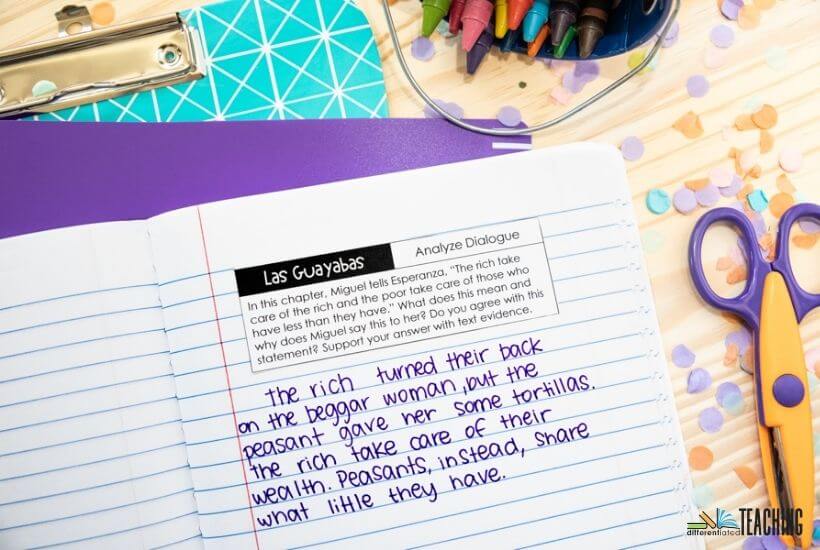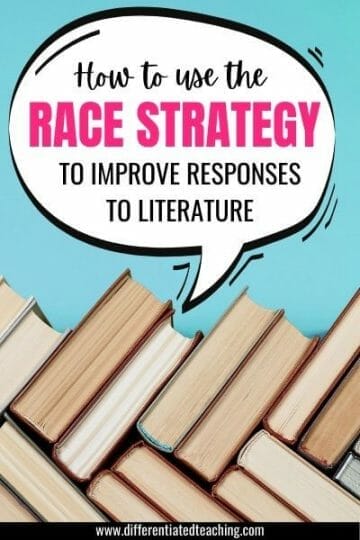
If you’re a teacher who is new to teaching the RACE strategy for responding to literature or looking for a refresher on how to teach this important skill, you’ve come to the right place. In this blog post, I’ll share an overview of the RACE writing strategy, including what it is and tips for getting your students started.

So whether you’re just starting out or are looking for new ideas, read on to learn more about teaching the RACE strategy!

The RACE strategy is a method for teaching students to write well-developed constructed responses. RACE stands for Restate, Answer, Cite Evidence, Explain.
As you may have guessed, RACE is not just for literature responses! However, it does make a great tool to help learners construct their answers in a clear, logical format.
The strategy makes remembering everything a teacher wants when answering reading response questions easy. Many teachers even use an anchor chart or checklist that helps students remember the key steps.
Let’s look at each step of the RACE framework in more detail!
The first thing your students will need to do when responding to a question is restate it so that the reader knows what they are answering.
The easiest way is teaching students to restate the question in a complete sentence. Model using examples like this one from The Giver, “The author of The Giver makes it clear that…” or “For readers to understand the main character Jonas fully, they must look at his relationship with his family members, especially his younger sister.”
Teach students to be specific in their sentence starters. In the example above, they wouldn’t want to say something as simple as “his relationship with his sister”. It won’t make sense on its own!
For struggling learners, you may want to provide sentence stems. These help model how to take part of the question and turn it into the main idea or topic sentence.
For any written response to literature, the most important step of the RACE writing strategy is to answer the question.
It’s important to teach students to give a clear answer that matches the question. This will be the statement that students plan to support with text evidence.
A good example would be if the question asks, “How does Jonas’ relationship with his sister change throughout the novel?”, a well-written answer might be “Jonas’ relationship with his sister changes from one of competition to one of care and protection.”
The next step is to cite evidence. This means selecting specific pieces of text that support the answer.
This is where having a close read of the text pays off! Students should underline, highlight, or otherwise mark relevant passages as they read.
When writing the response, they can easily find the needed evidence.
Remember to teach students to cite at least two pieces of evidence; more is better. This can include using direct quotes from the text. Just make sure that students understand how to format and cite these properly. This includes how to use quotation marks.
After students have selected their evidence, it’s time to explain why that evidence matters.
Students need to connect the relevant evidence back to the answer. It is also where they show how it supports their claim. For example, students might write, “The quote on page 47 shows how Jonas’ sister becomes an important part of his life, which supports the idea that their relationship changed from competition to care.”
This is also a good time to remind students to explain the context surrounding the evidence in their own words. What was happening in the story at that moment? What do we know about the characters involved? Answering these types of questions will help students write stronger explanations.

RACE is a helpful reimagining of the traditional paragraph structure teachers have instructed for decades: restate, answer the question, cite evidence from the text, and explain how the evidence proves your point.
The RACE strategy includes all of those elements but asks students to order them in a way that reads naturally as a paragraph rather than as four disconnected sentences.
The RACE strategy provides an excellent teaching opportunity for introducing students to writing with text evidence.
By practicing using their own ideas and citing specific examples from literature or other informational texts to support them, students will gain confidence in their ability to use text-based evidence in their writing—an essential skill for any student and one that will be especially helpful as students progress through school and as begin thinking about SATs, AP Exams, and college admissions essays!

The RACE strategy allows teachers to assess students’ understanding of a text and where misconceptions may have occurred.
When asked to support their answers with evidence from the text, it becomes immediately apparent whether or not learners have grasped the big ideas.
This is valuable information for teachers, who can use that data to inform further instruction.
The strategy gives an explicit structure to literature responses to help reduce overwhelm for struggling learners.
Many students become overwhelmed when looking at a blank page and figuring out how to start writing their thoughts about what they’ve read.
The RACE strategy offers a step-by-step guide that removes some of that anxiety by breaking the task into manageable chunks.

This can be especially helpful for struggling writers or those with learning disabilities, who may benefit from having a clear template to follow.
RACE can be used with any literature or informational text. The great thing about the RACE strategy is that it can be applied to just about any literature or informational text, making it an extremely versatile tool for teachers.
Teachers can introduce the RACE strategy to their students in a few different ways. I recommend modeling using a shared text regardless of how you do this. You’ll want to have a pre-developed question that you can respond to, along with the RACE acronym as a guide. You might even consider doing this model using the same question format that students will be responding to for their own reading as independent practice.

As you write, be sure to point out how each element of the response corresponds to one of the steps in the RACE strategy. You can also provide students with a printable handout or graphic organizer that outlines the steps of RACE so that they can refer to it as they write.
Once students are familiar with the basics of the RACE strategy, you can have them practice applying it to various literary texts and even to responses to questions in other subject areas.
Start by giving them a prompt or question to answer, then give them time to write their responses.
Afterward, you can review each student’s response and offer feedback on how well they applied the RACE strategy.

While there are many ways to respond to literature, the RACE strategy is an excellent framework for any text.
Teachers who implement this strategy in their classrooms will likely find that their students are better able to answer questions about what they’ve read and that they can support their answers with strong evidence from the text.

Ideal for teaching before introducing book clubs or novel studies, this response strategy is a valuable tool for any teacher looking to help their students write constructed responses, including paragraph responses to literature.